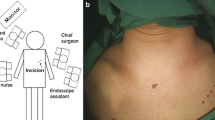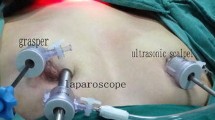Abstract
Background
Total thyroidectomy can be performed for Graves’ disease after a euthyroid state is achieved using inhibitors of thyroid hormone synthesis (thioamides). However, hypervascularization of the thyroid gland is associated with increased hemorrhage risk, in addition to complicating identification of the recurrent laryngeal nerve and parathyroid gland. Saturated iodine solution (Lugol’s solution) has been recommended to reduce thyroid gland hypervascularization and intraoperative blood loss, although this approach is not used at our center based on our experience that it induces thyroid firmness and potentially hypoparathyroidism.
Methods
This retrospective single-center study evaluated patients who underwent total thyroidectomy for Graves’ disease between November 2010 and November 2015. The rates of various complications at our center were compared to those from the literature (e.g., cervical hematoma, hypocalcemia, and recurrent laryngeal nerve palsy).
Results
Three hundred and eighty consecutive patients underwent total thyroidectomy without preoperative Lugol’s solution (311 women [81.84%] and 69 men [18.16%], mean age 43.41 years). No postoperative deaths were reported, although 30 patients (7.89%) experienced recurrent laryngeal nerve palsy and 9 patients experienced permanent injuries (2.37%). Hypoparathyroidism was experienced by 87 patients (25.53%) and 14 patients experienced permanent hypoparathyroidism (3.68%). Four patients required reoperation for cervical hematoma (1.05%; 2 deep and 2 superficial hematomas).
Conclusion
Despite the recommendation of iodine pretreatment, few of our non-pretreated patients experienced permanent nerve injury (2.37%) or permanent hypoparathyroidism (3.68%). These results are comparable to the outcomes from the literature. Randomized controlled trials are needed to determine whether iodine pretreatment is necessary before surgery for Graves’ disease.
Similar content being viewed by others
Change history
08 February 2018
In the original article, Mathieu Bonal’s last name was spelled incorrectly. It is correct as reflected here. The original article has also been updated.
References
De Leo S, Lee SY, Braverman LE (2016) Hyperthyroidism. Lancet 388:906–918
Ross D, Burch HB, Cooper DS et al (2016) 2016 American Thyroid Association guidelines for diagnosis and management of hyperthyroidism and other causes of thyrotoxicosis. Thyroid 26:1343–1421
Orgiazzi J (2011) The treatment of Graves’ disease: current views and controversies. Presse Med 40:1155–1162 (in French)
Pearce EN (2006) Diagnosis and management of thyrotoxicosis. BMJ 332:1369–1373
Huang SM, Liao WT, Lin CF et al (2015) Effectiveness and mechanism of preoperative lugol solution for reducing thyroid blood flow in patients with euthyroid Graves’ disease. World J Surg 40:505–509. https://doi.org/10.1007/s00268-015-3298-8
Erbil Y, Ozluk Y, Giris M et al (2007) Effect of lugol solution on thyroid gland blood flow and microvessel density in the patients with Graves’ disease. J Clin Endocrinol Metab 92:2182–2189
Daher R, Lifante JC, Voirin N et al (2015) Is it possible to limit the risks of thyroid surgery? Ann Endocrinol (Paris) 76(Suppl 1):S16–S26
Duclos A, Carty MJ, Peix JL et al (2012) Development of a charting method to monitor the individual performance of surgeons at the beginning of their career. PLoS ONE 7:e41944
Gaujoux S, Leenhardt L, Trésallet C et al (2006) Extensive thyroidectomy in Graves’ disease. J Am Coll Surg 202:868–873
Bojic T, Paunovic I, Diklic A et al (2015) Total thyroidectomy as a method of choice in the treatment of Graves’ disease-analysis of 1432 patients. BMC Surg 15:39–44
Stalberg P, Svensson A, Hessman AO et al (2008) Surgical treatment of Graves’ disease: evidence-based approach. World J Surg 32:1269–1277. https://doi.org/10.1007/s00268-008-9497-9
Liu ZW, Masterson L, Fish B et al (2015) Thyroid surgery for Graves’ disease and Graves’ ophthalmopathy. Cochrane Database Syst Rev 25:CD010576
Welch KC, McHenry CR (2011) Total thyroidectomy: Is morbidity higher for Graves’ disease than nontoxic goiter? J Surg Res 170:96–99
Chang DC, Wheeler MH, Woodcock JP et al (1987) The effect of preoperative Lugol’s iodine on thyroid blood flow in patients with Graves’ hyperthyroidism. Surgery 102:1055–1061
Ansaldo GL, Pretolesi F, Varaldo E et al (2000) Doppler evaluation of intrathyroid arterial resistances during preoperative treatment with Lugol’s iodide solution in patients with diffuse toxic goiter. J Am Coll Surg 191:607–612
Burch HB, Cooper DS (2015) Management of Graves’ disease: a review. JAMA 314:2544–2554
Shinall MC Jr., Broome JT, Baker A et al (2013) Is potassium iodide solution necessary before total thyroidectomy for Graves disease? Ann Surg Oncol 20:2964–2967
Robert J, Mariéthoz S, Pache JC et al (2001) Short- and long-term results of total vs subtotal thyroidectomies in the surgical treatment of Graves’ disease. Swiss Surg 7:20–24
Lifante JC, Payet C, Menegaux F et al (2017) Can we consider immediate complications after thyroidectomy as a quality metric of operation? Surgery 161:156–165
Barczynski M, Konturek A, Cichon S (2009) Randomized clinical trial of visualization versus neuromonitoring of recurrent laryngeal nerves during thyroidectomy. Br J Surg 96:240–246
Acknowledgements
We thank Editage (www.editage.com) for English language editing.
Author information
Authors and Affiliations
Corresponding author
Ethics declarations
Conflict of interest
The authors report that they have no conflict of interest that is relevant to this report.
Additional information
The original version of this article was revised: Mathieu Bonal's last name was spelled incorrectly.
Rights and permissions
About this article
Cite this article
Mercier, F., Bonal, M., Fanget, F. et al. Does Surgery Without Lugol’s Solution Pretreatment for Graves’ Disease Increase Surgical Morbidity?. World J Surg 42, 2123–2126 (2018). https://doi.org/10.1007/s00268-017-4443-3
Published:
Issue Date:
DOI: https://doi.org/10.1007/s00268-017-4443-3




